Excerpts from Jim Conrad's
Naturalist Newsletter
Entry from field notes dated June 28, 2023, taken in ridgetop forest largely of low-growing Quercus laeta, ridge rising on the southwestern side of Curva de la Doctorcilla, which is near km 18 on the branch road beginning at El Campamento and continuing to El Doctor, and which is numbered Hwy 120, though it branches off the main Hwy 120 running between San Juan del Río and Jalpan; limestone bedrock; elevation ~2930m (~9600 ft), Querétaro, MÉXICO, (N20.85971°, W99.60541°)
"CENTURY PLANT"/ "PULQUE AGAVE"
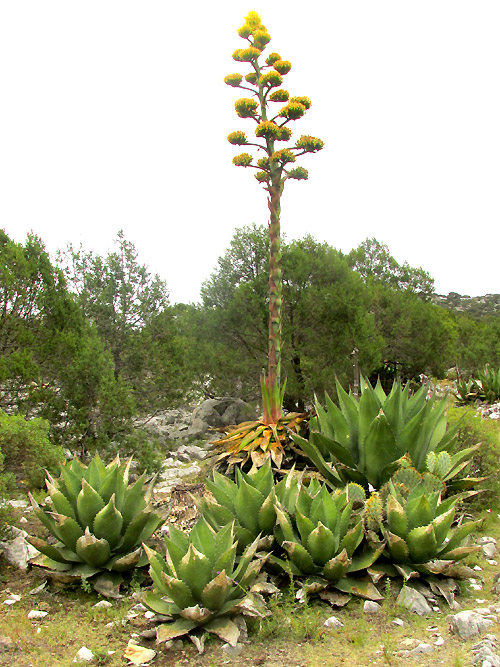
In the valley about 2kms NW of the above coordinates, at about 2800m in elevation and where junipers were the dominant trees, the above agave was flowering. Notice that its leaves are wilting, turning yellow, and dying. I read that under average conditions such "century plants" live for 15-25 years before flowering and immediately dying, though sometimes they've been documented surviving up to 80 years. Typically they issue sprouts, or pups, at their bases, so when the main plant dies, one or more pups take over.
Several giant species are known by the names of Century Plant, Giant Agave, Pulque Agave, Maguey and the like, and can be hard to distinguish. Often it's important to count the dense flower clusters, or umbels, comprising a flowering individual's inflorescence. The above has approximately 26.

The above umbels are a little past their flowering period, but it appears that the flowers have been bright yellow, not yellow-green, or tipped with red. Notice the brown, sharp-pointed bracts. They differ among the species with regard to whether they're fleshy or leathery, and whether they remain on the rachis after flowering, or fall off. These look leathery and deciduous.
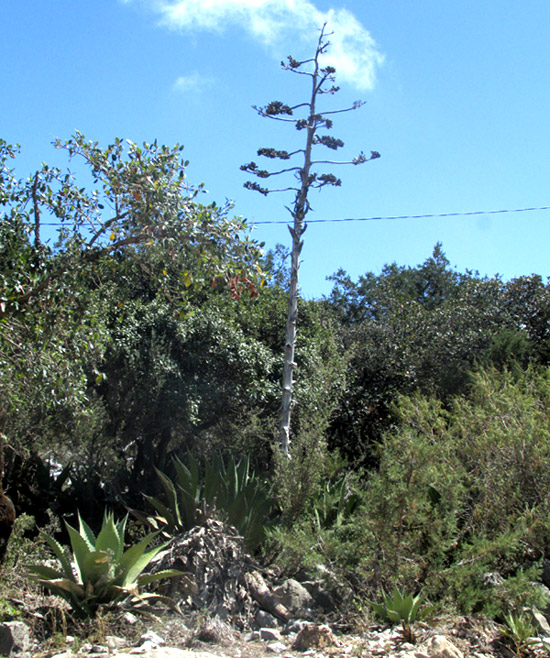
At the coordinates and higher elevation stated atop the page, where oaks and pines prevailed, the above plant of the same species was fruiting. The following pictures show features of younger plants surrounding it.

Leaves of the above shoulder-high plant, compared with other species of cultivated and endemic wild agaves in this region, are proportionally broad relative to their lengths, and bear large spines. They can be compared to those of two other commonly occurring giant agaves in this area, Agave atrovirens, and Agave americana.
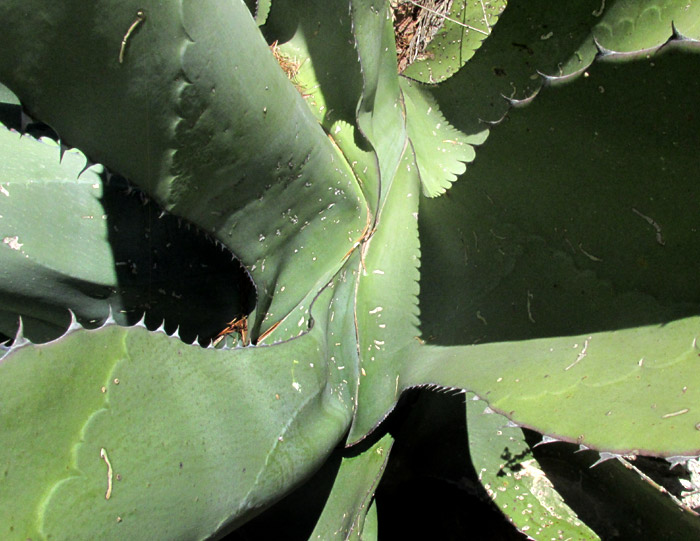
The leaf bases narrow considerably from their widest point, and the margin's spines are relatively tall and broad-based.
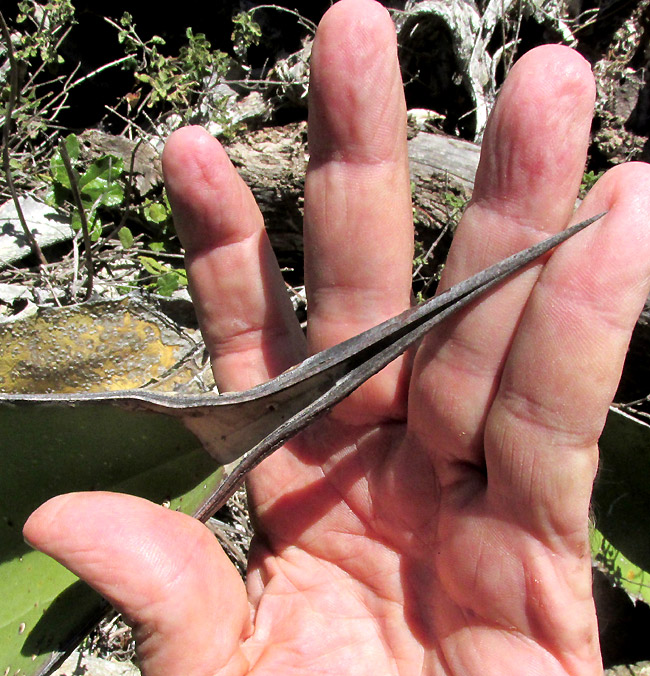
The leaf tip makes an involuted, wood-hard, very sharp point about 8 cm long (3 inches)
During the technical identification of giant agaves, an important feature to note is the flower size. Because flowering individuals are so rare, I don't chop down inflorescences to measure the blossoms. Still, once the eye becomes practiced, inflorescence shape and vegetative features usually are enough to designate the species. Mainly depending on technical features provided in the 2011 Agave treatment of the Flora del Valle de Tehucán-Cuicatlán, the plants shown on this page appear to be AGAVE SALMIANA.
The Flora notes that for Agave salmiana the literature offers an abundancia of synonyms. That's largely due to the species' great plasticity arising from wild plants hybridizing with cultivated ones. The Flora recognizes two subspecies, but other authorities mention more or fewer. To me, our plants don't neatly fit either of the two Flora subspecies.
Agave salmiana is endemic just to central and southern Mexico, but is cultivated and escaped in various countries. My impression is that here in central upland Mexico the species is the main one encountered in the mountains, while on the altiplano, or high-elevation plains, the main species ecountered is Agave americana.
The Flora del Valle de Tehucán-Cuicatlán describes the inflorescences of Agave salmiana as reaching up to 8m tall (26ft), though an individual on the campus of the University of California Berkeley, according to the 1989 edition of the Guinness Book of World Records, reached 16m (52ft). That was the tallest inflorescence ever recorded of any known plant species.
The 2007 study by David Castillo Quiroz and others entitled "El Género Avave L. Bajo Cultivo: Taxonomiá, Distribución y Usos" lists the uses of Agave salmiana as: to establish and protect property boundaries; burning the leaves as firewood; cutting up the inflorescence for livestock forage; for the extraction of aguamiel, the plant's sap, which when fermented forms the Mexican traditional alcoholic drink pulque; for reforestation, and; for reclaiming abandoned, exhausted land.
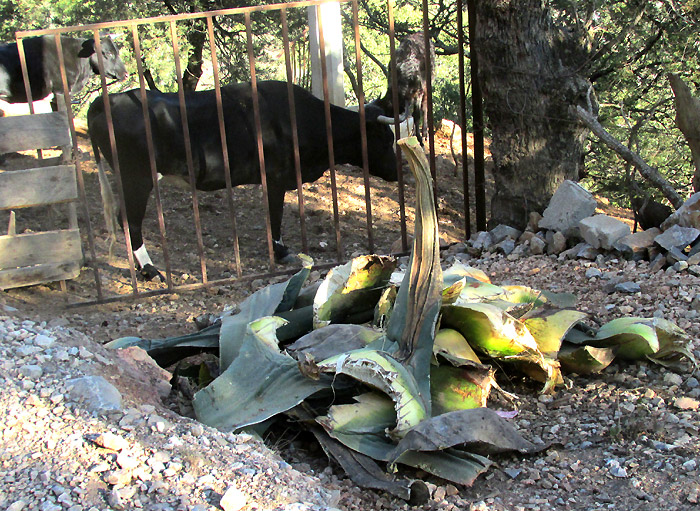
Above you see one use -- in this region possibly the main use -- for Agave salmiana: that of feeding the leaves to cattle. Elsewhere I've seen ranchers with machetes cutting agave leaves into hand-sized chunks for cattle feed. I read that goats also eat it as agave forage.